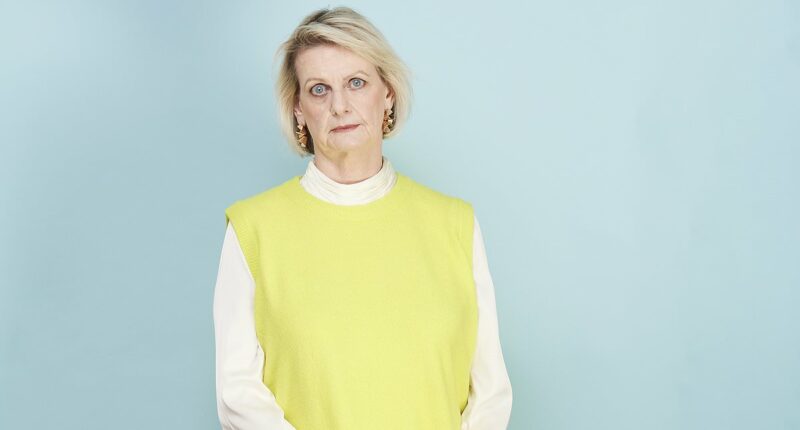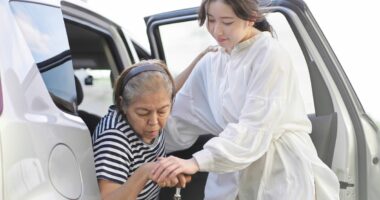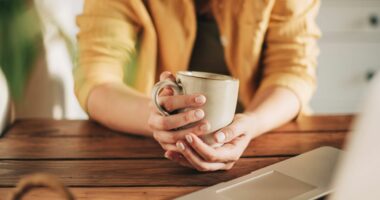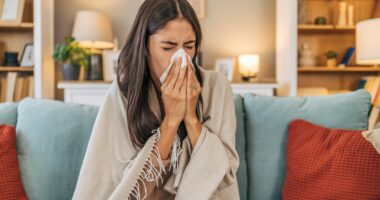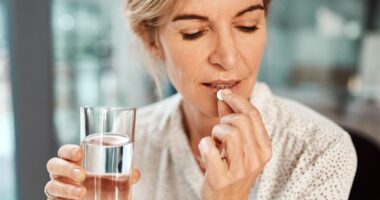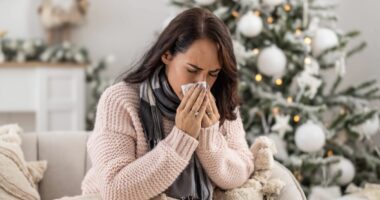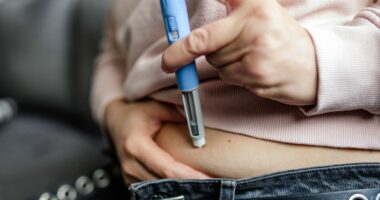Share this @internewscast.com
The unsettling question, “What if I’m dying?” permeated my thoughts, refusing to budge. I had spent most of the day cocooned in bed, drifting in and out of restless sleep, feeling overwhelmingly unwell.
It all began the previous day with a simple upset stomach, which gradually escalated into a relentless headache, accompanied by nausea, crushing fatigue, and a fever.
The fever was particularly unbearable. I oscillated between feeling unbearably hot and drenched in sweat to shivering from an intense chill, with moments so disconcerting that I couldn’t distinguish one from the other.
My heart raced at an alarming pace, leaving me breathless and anxious—a state that only heightened my fear of the worst-case scenario.
Contemplating whether I should rouse myself to ask my husband, Paul, to drive me to the emergency room, I recoiled at the thought. The prospect of enduring hours in a waiting area seemed, ironically, more dreadful than the fear of my own mortality.
What I was experiencing turned out to be a diverticulitis flare-up, an episode that had incapacitated me like never before.
Diverticulitis occurs when pouches (called diverticula) form in the intestinal walls and become inflamed or infected by a build-up of bacteria. The pouches can be as big as 20mm (three-quarters of an inch) in some people.
Diverticulitis can cause extreme pain – women who suffer from it say it’s worse than childbirth.
In severe cases, an abscess can form and the pouch may burst, which can cause peritonitis (inflammation of the abdomen) or even sepsis, a potentially life-threatening overreaction of the immune system.
By the age of 80, around 70 per cent of people will have diverticula, but most won’t know as there are no symptoms.
Why these pouches become inflamed and infected for some people but not others is not yet known, but it becomes increasingly common from the age of 40 as the intestinal wall weakens with age.
And it doesn’t help that many of those with diverticula are given the wrong dietary advice, which could make the problem worse (but more on that later).

The thought of sitting in A&E for four hours or more was, almost literally, writes Nicola Jane Swinney, a fate worse than death

Women who suffer from diverticulitis say it’s worse than childbirth, as the condition can cause extreme pain, nausea and fever
The charity Guts UK says as many as one in two of us develop diverticulitis – and that number is growing.
Indeed, hospital admissions for diverticulitis have more than doubled over the past decade, says Professor Bu’Hussain Hayee, clinical director for liver, endoscopy and gastroenterology at King’s College Hospital NHS Foundation Trust.
This is partly because of our ageing population, he says, but there are other factors, including obesity (this increases inflammation generally), sedentary lifestyles and a lack of fibre – which slow the transit of waste through the colon.
He adds smoking and certain medications, such as non-steroidal anti-inflammatory drugs and steroids, can also cause colon inflammation.
One problem is the symptoms, such as diarrhoea, abdominal pain, bloating and nausea – together with a change in bowel habits and a dull pain in the abdomen – can be mistaken for irritable bowel syndrome (IBS), plus some patients suffer both.
‘There is a significant overlap,’ says Professor Hayee.
Blood in the stool, meanwhile – caused by the pouches bleeding – can be dismissed as piles.
Diagnosis is one thing – learning how to manage the condition is another
When in 2020, aged 57, I started feeling feverish and unwell for days, my GP ordered blood tests to identify the cause – but they all came back as normal. During a particularly bad bout in March 2021, I phoned her, and she asked me to go into the surgery.
Noting my raised temperature and elevated heart rate, she diagnosed diverticulitis and immediately despatched me to a gastroenterologist at the Princess Royal University Hospital in Bromley, south-east London.
The consultant felt the left side of my abdomen – which typically will cause lots of pain in someone with a diverticulitis flare-up as it is where diverticula occur.
Perhaps because I wasn’t in pain, the gastroenterologist decided I didn’t have diverticulitis and sent me home. I could only manage water for days, but my symptoms gradually subsided.
It would be after yet another flare-up a couple of months later – when I thought I was dying – that I would finally be sent for a colonoscopy, which revealed the diverticula in my intestinal wall, each 2mm to 10mm in size. This, together with my symptoms, confirmed I had diverticulitis.
Diagnosis is one thing, learning how to manage the condition is another. And there seems to be a lot of misinformation about this.
Many with diverticulitis are still told to avoid high-fibre foods such as peas, beans, apples, bananas, avocados, carrots and barley, for instance.
But Guts UK says these should be added to the diet as they bulk up the stool, hastening its transit and reducing pressure on any pouches in the gut wall.
‘Long-term studies do not link diet as a primary cause,’ adds Professor Hayee.
Avoiding fibre is only suggested when complications occur – such as when an infected pouch ruptures, allowing waste into the abdominal cavity.
People with diverticula may also be told – wrongly – to avoid things such as berries, or any other kind of seed, fruit or vegetable skins, popcorn and nuts – again, because it was thought to be these lodged into the pouches.
But this has been refuted by multiple studies, including one published in the Annals of Internal Medicine earlier this year.
Separately, some people with diverticula say they cannot tolerate onions, red meat or tomatoes, for example. But Professor Hayee doesn’t believe these bring on diverticulitis.
A low-Fodmap (fermentable oligosaccharides, disaccharides, monosaccharides and polyols) diet is sometimes suggested.
Fodmaps are fermentable carbohydrates found in bread, pasta, breakfast cereals, stone fruit, apples, beans and pulses. In short, the diet is very restrictive.
Julie Thompson, a gastroenterology dietitian and information manager at Guts UK, says the low-Fodmap diet can be ‘extremely successful’ in treating IBS, ‘but it is not recommended for those with diverticulitis’. In fact, says Professor Hayee, people with diverticula can eat a normal diet – but are advised to switch to fluids only during a flare-up, and some may need antibiotics to clear the infection.
Those who develop frequent infections or abscesses may be offered surgery to remove the affected part of the gut, with the two ‘ends’ being joined back up.
I get four or five flare-ups each year – the worst I’ve ever had was in January this year, when I lost 8lb in four days.
Trial and error has taught me how to manage my condition.
I have a rescue pack of antibiotics in the house, which I go on to when a flare-up reaches the shivering/sweating phase – and I always drink between two and three litres of water a day.
I try to eat more fibre and sometimes take psyllium husk to up my intake.
If I have a bout of diarrhoea, I switch to a water-only diet for a couple of days and get as much sleep as I can.
After a flare-up I find it difficult to start eating again, because I am terrified of setting off the symptoms. On one occasion, I’d been ill for five days but was starting to feel better and ate a small amount of chicken, carrot and celery. I spent most of that night in the bathroom – and the following day I was back in bed, sweating and freezing.
Despite what Professor Hayee says, I find it better to avoid fibre after a flare-up. As a friend and fellow sufferer puts it ‘eating fibre while the gut is still inflamed is like applying sandpaper to a graze’.
Even when I’m not in a flare-up, I am rarely completely ‘well’. I suffer from fatigue, frequent stomach upsets and often feel nauseous.
But there is a glimmer of hope. A treatment is being trialled in which the little pouches are closed surgically. The clips are inserted via an endoscope – a long thin tube – while the patient is under conscious sedation.
Professor Hayee says: ‘My team at King’s have published research that shows clipping is safe and reduces symptoms [of diverticulitis] and IBS, as well as reducing the frequency of diverticulitis episodes.’
The pilot study was published in the journal Gut in 2019 and the full results, which Professor Hayee tells me look ‘very promising’, will be published soon.
For my fellow sufferers and I, it could be the game-changer we have been waiting for.
For more information visit gutscharity.org.uk and bowelresearchuk.org
